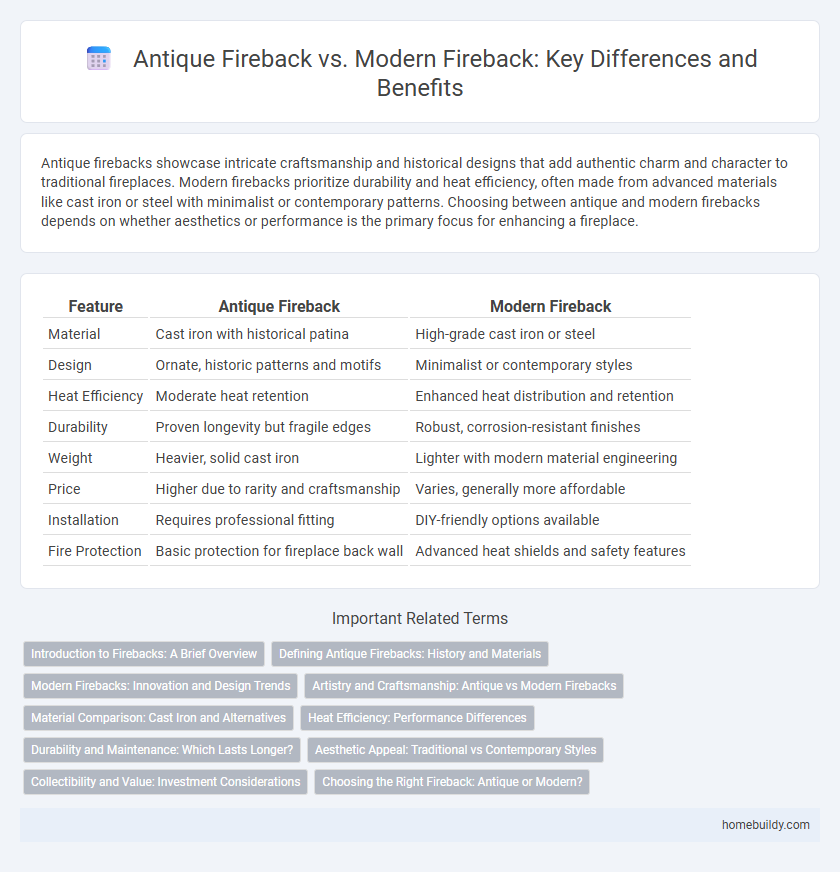Antique firebacks showcase intricate craftsmanship and historical designs that add authentic charm and character to traditional fireplaces. Modern firebacks prioritize durability and heat efficiency, often made from advanced materials like cast iron or steel with minimalist or contemporary patterns. Choosing between antique and modern firebacks depends on whether aesthetics or performance is the primary focus for enhancing a fireplace.
Table of Comparison
| Feature | Antique Fireback | Modern Fireback |
|---|---|---|
| Material | Cast iron with historical patina | High-grade cast iron or steel |
| Design | Ornate, historic patterns and motifs | Minimalist or contemporary styles |
| Heat Efficiency | Moderate heat retention | Enhanced heat distribution and retention |
| Durability | Proven longevity but fragile edges | Robust, corrosion-resistant finishes |
| Weight | Heavier, solid cast iron | Lighter with modern material engineering |
| Price | Higher due to rarity and craftsmanship | Varies, generally more affordable |
| Installation | Requires professional fitting | DIY-friendly options available |
| Fire Protection | Basic protection for fireplace back wall | Advanced heat shields and safety features |
Introduction to Firebacks: A Brief Overview
Firebacks serve as protective and decorative plates mounted at the back of a fireplace, designed to reflect heat into the room and shield the chimney. Antique firebacks, often cast from heavy iron with intricate designs, showcase historical craftsmanship and patina, enhancing vintage fireplace aesthetics. Modern firebacks prioritize heat efficiency and sleek styling, incorporating advanced materials for durability and optimized heat radiation.
Defining Antique Firebacks: History and Materials
Antique firebacks date back to the 16th and 17th centuries, originally crafted in Europe to protect masonry fireplaces from heat damage and to radiate heat efficiently. These firebacks were typically made from cast iron or wrought iron, often featuring intricate designs and heraldic motifs that reflect their historical and cultural significance. Their heavy, durable materials and artistic craftsmanship distinguish antique firebacks from modern counterparts, which often prioritize function over decorative detail.
Modern Firebacks: Innovation and Design Trends
Modern firebacks feature advanced heat-resistant materials like cast iron alloys and steel composites that enhance durability and heat distribution compared to antique firebacks. Contemporary designs integrate artistic motifs with minimalist aesthetics, incorporating geometric patterns and sleek finishes to complement modern interior decor. Innovations such as modular firebacks and customizable options cater to functional efficiency and personalized style, setting modern firebacks apart in both performance and visual appeal.
Artistry and Craftsmanship: Antique vs Modern Firebacks
Antique firebacks showcase intricate hand-forged designs reflecting centuries-old metallurgical techniques and artistic motifs, emphasizing unique craftsmanship and historical value. Modern firebacks often incorporate advanced casting technologies, allowing for precise detailing and consistent reproductions but sometimes lack the individuality and wear that characterize antiques. The artistry in antique firebacks highlights traditional patterns and patina, whereas modern versions offer contemporary styles with enhanced durability and heat-resistant alloys.
Material Comparison: Cast Iron and Alternatives
Antique firebacks are predominantly crafted from cast iron, valued for its exceptional heat retention and durability, which enhances fireplace efficiency by radiating consistent warmth. Modern firebacks may incorporate alternative materials such as steel or ceramics, offering lighter weight and diverse design options while sometimes sacrificing the robust heat retention characteristic of cast iron. Cast iron remains preferred for its longevity and ability to withstand high temperatures, whereas alternatives provide cost-effective and customizable solutions for contemporary fireplaces.
Heat Efficiency: Performance Differences
Antique firebacks, typically made from cast iron, often feature thicker designs that absorb and radiate heat slowly, providing steady warmth but with lower overall efficiency compared to modern firebacks. Modern firebacks incorporate advanced materials and engineering, such as thinner cast iron with optimized surface patterns, increasing heat transfer and enhancing energy efficiency in wood-burning fireplaces. Performance differences highlight that contemporary firebacks return more usable heat into living spaces, reducing fuel consumption and improving heating effectiveness.
Durability and Maintenance: Which Lasts Longer?
Antique firebacks, often cast from high-quality cast iron, offer excellent durability due to their thick construction and traditional manufacturing techniques, yet they may require careful maintenance to prevent rust and cracks caused by age. Modern firebacks incorporate advanced materials and protective coatings that enhance resistance to corrosion and thermal stresses, reducing maintenance needs and extending longevity. Overall, modern firebacks generally last longer with less upkeep, while antique firebacks demand meticulous care to preserve their durability over time.
Aesthetic Appeal: Traditional vs Contemporary Styles
Antique firebacks feature intricate, hand-forged designs with classic motifs such as floral patterns and historical scenes, creating a nostalgic and timeless aesthetic that enhances traditional fireplace settings. Modern firebacks prioritize sleek, minimalistic designs with clean lines and abstract elements, aligning with contemporary interior decor trends. The choice between antique and modern firebacks significantly impacts the overall visual harmony and character of a hearth, catering to either heritage charm or modern sophistication.
Collectibility and Value: Investment Considerations
Antique firebacks often hold greater collectibility and value due to their historic craftsmanship, unique designs, and limited availability, making them sought-after by collectors and investors. Modern firebacks, while functional and customizable, typically lack the rarity and provenance that drive higher investment potential in antiques. Evaluating factors such as age, maker's marks, condition, and historical significance is essential in determining the long-term value of vintage firebacks as investment pieces.
Choosing the Right Fireback: Antique or Modern?
Choosing the right fireback depends on both aesthetic preference and functional needs, with antique firebacks offering unique craftsmanship and historical charm, often made from durable cast iron featuring intricate designs. Modern firebacks provide enhanced heat efficiency and corrosion resistance, utilizing advanced materials and manufacturing techniques to improve fireplace performance. Assessing factors such as style compatibility, heat radiation, and maintenance requirements helps determine whether an antique or modern fireback best suits your fireplace setup.
Antique Fireback vs Modern Fireback Infographic

 homebuildy.com
homebuildy.com